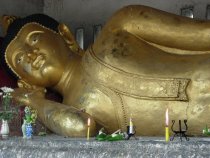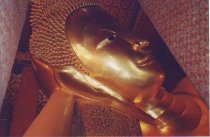 There is some debate about the exact date of birth of Gautama Buddha, but general consensus seems to put it at around 500 to 400 B.C. He was born as Prince Gautama Siddharta into a royal warrior family in what was northern India (now Nepal). At the time of his birth, astrologers predicted he would either become a great king or a spiritual saviour depending on which path he chose in life. Gautama’s father wanted him to become a great king and the young prince was restricted to life within the palace grounds living a pampered and sheltered existence. During this time he would have worn heavy jewels and precious stones in his ears and this is why many Buddha images depict him with elongated earlobes. Although Gautama married and became a father, he later went against his father’s authority by leaving the palace. In the outside world he encountered the suffering of the people. He went on to live a life of self-denial and self-mortification in an attempt to find out why pain and suffering was intrinsic to human life.
There is some debate about the exact date of birth of Gautama Buddha, but general consensus seems to put it at around 500 to 400 B.C. He was born as Prince Gautama Siddharta into a royal warrior family in what was northern India (now Nepal). At the time of his birth, astrologers predicted he would either become a great king or a spiritual saviour depending on which path he chose in life. Gautama’s father wanted him to become a great king and the young prince was restricted to life within the palace grounds living a pampered and sheltered existence. During this time he would have worn heavy jewels and precious stones in his ears and this is why many Buddha images depict him with elongated earlobes. Although Gautama married and became a father, he later went against his father’s authority by leaving the palace. In the outside world he encountered the suffering of the people. He went on to live a life of self-denial and self-mortification in an attempt to find out why pain and suffering was intrinsic to human life.
Gautama wandered the countryside for a number of years without coming any closer to the answer. Eventually he realized that the body needed to be physically fit to train the mind in order to attain enlightenment. Just as following a path of decadence was not the way forward, nor was following a path of self-imposed deprivation. Instead, he would follow the ‘Middle Way’; neither over-indulgent nor too austere.
Gautama sat down beside a riverside bodhi tree and assuming the cross-legged lotus position, he began to meditate. For 49 days he contemplated the causes of suffering. As he meditated, Mara (the Evil One) tried to distract him by sending temptation his way. Mara was finally subdued when Gautama summoned the earth goddess, Mae Thoranee, by pointing the fingers of his right hand at the ground. This gesture is known as Bhumisparsa Mudra and can be seen on many statues and depictions of Buddha in Thailand. The earth goddess was able to wring her hair and produce floods of water which defeated Mara and her minions.
With temptation defeated, Gautama attained enlightenment and by doing so became a Buddha. He was 35-years-old. The bodhi tree (or bo tree) now has special significance for Buddhists and can often be seen inside the grounds of a Thai wat.
The Buddha preached his first sermon at a deer park in India. His Dharma (doctrine or teachings) were characterized as a wheel and this symbol is known as Dharmachakra, the Wheel of Doctrine (or Wheel of Life, Wheel of Law). This symbol can be seen on Thai religious flags and Thai temples often have depictions of deer (as statues or on murals) to commemorate the place where the Buddha’s first sermon was made. In Thailand, the preaching of this first sermon is commemorated on Asana Puja Day in July.
The spontaneous gathering of over 1,000 followers to hear the Buddha speak is commemorated by another Thai public holiday, Makha Puja Day, in February.
For over 40 years the Buddha travelled the region of India and preached and performed miracles gathering followers as he did so. During this time he temporarily returned to his father’s palace and was reunited with his wife and child.
 The Buddha died at the age of 80 by the banks of a river at Kusinari in India. Lying on his side with his head propped up by his hand and a serene expression, the Buddha passed into Nirvana. This moment is captured in the image of the Reclining Buddha which can be seen in many statues throughout Thailand, most famously at Wat Po in Bangkok (pictured above). Nirvana is a blissful state with no suffering and no reincarnation.
The Buddha died at the age of 80 by the banks of a river at Kusinari in India. Lying on his side with his head propped up by his hand and a serene expression, the Buddha passed into Nirvana. This moment is captured in the image of the Reclining Buddha which can be seen in many statues throughout Thailand, most famously at Wat Po in Bangkok (pictured above). Nirvana is a blissful state with no suffering and no reincarnation.
(photo at the very top of this article shows the Reclining Buddha at Wat Chieng Man in Chiang Mai)
Buddhists believe that the Buddha was born, attained enlightenment and entered Nirvana on the same date and this is commemorated on the day of the full moon in the sixth lunar month (usually May but sometimes June) and is known as Visakha Puja Day.
Photographs: © thaizer.com